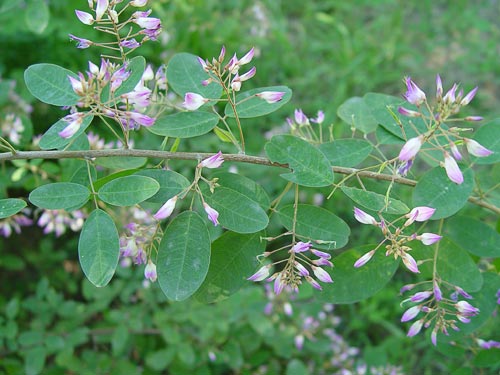Relatives
Lespedeza bicolor Turcz. - Lespedeza two-color.
Taxonomic position.
Family Fabaceae Lindl., genus Lespedeza Michx.Morphology and biology.
A perennial plant that ranges from 1 to 1.5 m in height. Stem is thin with numerous branches. The bark of young branches is green, covered by sparse, compressed, white hairs. On old branches, the bark is gray-brown, shelled. Leaves are on long stalks with three leaflets. There are calloused thickenings on the bases of stalks, as well as on stalks of lateral and upper leaflets. Leaflets are oval, round or oval-elliptical. Plates of leaflets are full, blunt or with small dredging on top and with a short, thin thorn, which is a continuation of the main vein. Upper surfaces of leaves are bright green; lower surfaces are glaucous, green. Young leaves have dense, silky pubescence; older leaves have sparse, compressed hairs, which are denser along the main vein. Stipules are small, subulate. Inflorescence is a complex, pyramidal panicle. There are 2 stipules; they are fine, up to 1 mm in length, linear, with ciliate edges. Pedicelis are pubescent, approximately equal to the calyx in length. Calyx is 3.5-4 mm in length, with 4 shares. The bottom share is the longest, linear; lateral ones are lanceolate. The top share has dredging above. Corolla is 9-13 mm in length, red or pink-violet. Keel is longer than wings. Pod is 5-7 mm in length, flat, monospermous, oblique round-elliptical, with a short column and a network of veins. Seeds have light brown spots. Blossoms in July-August; fructifies in September.Distribution.
The common distribution area includes Manchuria, Korea, and Eastern Mongolia. Within the former USSR, the species occurs in the Far East (Zeya, Bureinsky and Ussurijsky areas) and Eastern Siberia (eastern Daursky area).Ecology.
Occurs on the edges of woods, in oak and birchwoods, on rocky breakages, and in cleared woodlands. In drained and crushed stone soils, the species forms continuous thickets.Use and economic value.
In Europe, it is raised as a decorative bush. In Primorski Krai, it is used as a valuable fodder plant, especially for spotted deer. Animals eat young branches all year. A good honey plant with the long period of flowering.References:
Cherepanov S.K. 1995. Plantae Vasculares Rossicae et Civitatum Collimitanearum (in limicis USSR olim). St. Petersburg, Mir I Semia, 990 p. (in Russian).Kharkevich S.S., ed. 1989. Vascular Plants of the Soviet Far East. Vol. 4. Leningrad: Nauka, 380 p. (in Russian).
Malyshev L.I., Peshkova G.A., eds. 1979. Flora of Central Siberia. Vol. 2. Novosibirsk: Nauka, 630 pp. (in Russian).
Polozhij A.V., Malyshev L.I., eds. 1994. Flora of Siberia. Vol. 9. Fabaceae (Leguminosae). Novosibirsk: Nauka, p. 12. (in Russian).
Shishkin B.K., Bobrov E.G., eds. 1948. Flora of the USSR. Vol. 13. M.-L.: Publishing House of Acad. Science, p. 379. (in Russian).


